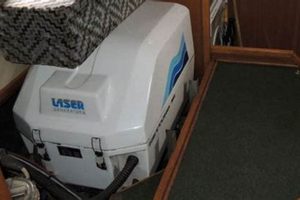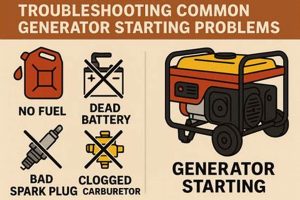Operating a portable generator safely and effectively involves several key steps. These include understanding the generator’s power output and connecting appropriate appliances, grounding the unit to prevent electrical shocks, refueling with the correct fuel type while the engine is off and cool, and operating the generator in a well-ventilated area to avoid carbon monoxide poisoning. Proper starting and shutdown procedures are also crucial for safe and efficient operation. For example, connecting appliances before starting the generator can overload the system, while refueling a hot engine presents a significant fire hazard.
Portable generators provide a crucial source of backup power during outages caused by severe weather, grid failures, or other unforeseen circumstances. They enable continued operation of essential appliances like refrigerators, sump pumps, and medical equipment, protecting food from spoilage, preventing basement flooding, and maintaining life-support systems. This capability offers peace of mind and enhances safety and well-being during emergencies. Historically, generators have evolved significantly from bulky, noisy machines to more compact and quieter models, making them a more practical and accessible power solution for various applications.
This article will further explore essential aspects of generator operation, including detailed safety precautions, proper connection procedures, maintenance guidelines, and tips for maximizing efficiency and longevity. Additionally, considerations for selecting the right generator size and fuel type will be addressed, empowering readers to make informed decisions and safely harness the benefits of portable power.
Safe and Effective Portable Generator Operation Tips
These tips provide essential guidance for the safe and effective use of portable generators, emphasizing crucial safety precautions and operational best practices.
Tip 1: Consult the Owner’s Manual: Before operating a generator, thoroughly review the manufacturer’s instructions provided in the owner’s manual. This document contains critical safety information specific to the generator model.
Tip 2: Proper Ventilation is Crucial: Operate generators outdoors in well-ventilated areas, far from windows, doors, and vents. This prevents carbon monoxide buildup, a colorless, odorless, and potentially lethal gas.
Tip 3: Ground the Generator: Properly ground the generator according to the manufacturer’s instructions. Grounding protects against electrical shock hazards.
Tip 4: Safe Refueling Procedures: Turn off the generator and allow it to cool completely before refueling. Gasoline and other fuels are flammable and pose a fire risk when handled near hot engine components.
Tip 5: Avoid Overloading: Calculate the total wattage of appliances to be connected and ensure it does not exceed the generator’s rated output. Overloading can damage the generator and connected appliances.
Tip 6: Dry Operation is Essential: Never operate a generator in wet or damp conditions. Protect the unit from rain and snow to prevent electrical hazards.
Tip 7: Regular Maintenance: Perform routine maintenance according to the manufacturer’s recommendations. This includes oil changes, air filter cleaning, and spark plug replacement. Proper maintenance ensures optimal performance and longevity.
Tip 8: Proper Storage: When not in use, store the generator in a dry, well-ventilated area, away from flammable materials. Stabilize the fuel or drain the fuel tank completely before long-term storage.
Adhering to these guidelines ensures safe and reliable generator operation, maximizing its lifespan and minimizing potential risks. Careful planning and responsible operation are essential for harnessing the full potential of portable power generation.
By following these guidelines, users can confidently operate their portable generators safely and efficiently, ensuring a reliable power source during emergencies and other situations requiring temporary power.
1. Safety First
Prioritizing safety is paramount when operating portable generators. The potential hazards associated with improper use, including carbon monoxide poisoning, fire, and electrical shock, necessitate a cautious and informed approach. Understanding the “Safety First” principle is inextricably linked to proper generator operation. For instance, failing to operate a generator in a well-ventilated area can lead to a buildup of carbon monoxide, resulting in severe health consequences or even fatalities. Similarly, neglecting to ground the generator can create an electrical shock hazard, particularly in damp conditions. These real-world dangers underscore the critical importance of prioritizing safety when using portable generators.
Practical application of the “Safety First” principle involves a multi-pronged approach. This includes a thorough understanding of the manufacturer’s safety guidelines, ensuring proper ventilation by operating the generator outdoors and away from buildings, and correctly grounding the unit to prevent electrical shocks. Further safety measures involve allowing the generator to cool completely before refueling to mitigate fire hazards and avoiding overloading the generator, which can damage the unit and connected appliances. These practical steps, taken in conjunction with a comprehensive understanding of the potential dangers, form the cornerstone of safe generator operation.
In conclusion, “Safety First” is not merely a slogan but a critical operational principle for portable generators. It represents a comprehensive approach encompassing proper grounding, ventilation, refueling procedures, and adherence to manufacturer guidelines. Ignoring these safety protocols can have severe, potentially life-threatening consequences. Understanding and implementing these safety measures ensures responsible generator use and mitigates the risks associated with portable power generation.
2. Proper Connection
Proper connection is a critical aspect of safe and effective portable generator operation. It directly impacts the functionality and longevity of both the generator and the connected appliances. Incorrect connection procedures can lead to a range of issues, from appliance malfunction and generator damage to potential safety hazards like electrical shocks and fires. Understanding the principles of proper connection is therefore essential for anyone utilizing a portable generator. For instance, connecting devices with wattage requirements exceeding the generator’s capacity can overload the system, causing damage to the generator’s internal components and potentially creating a fire hazard. Conversely, using undersized wiring can lead to overheating and electrical shorts, posing a risk of fire or shock. Therefore, the correct matching of wattage and wiring is crucial for safe and efficient operation.
The practical application of proper connection involves several key steps. Firstly, calculating the total wattage of all appliances intended for connection is crucial to avoid overloading the generator. Secondly, selecting appropriate extension cords and power cables with sufficient current-carrying capacity is essential to prevent overheating and voltage drops. Thirdly, utilizing the correct type of receptacles and ensuring secure connections minimize the risk of sparks and electrical hazards. Finally, following the manufacturer’s instructions for connecting specific appliances helps ensure compatibility and prevents damage. For example, certain appliances, such as refrigerators and air conditioners, may require dedicated circuits or special starting procedures due to their high initial power demands. Neglecting these specific requirements can lead to appliance malfunction or generator overload.
In conclusion, proper connection is an integral component of safe and effective portable generator use. It involves careful consideration of wattage requirements, appropriate wiring selection, secure connections, and adherence to manufacturer guidelines. Understanding and implementing these principles protects both the generator and connected appliances, ensuring safe and reliable power delivery while mitigating potential risks. Failure to observe proper connection protocols can result in equipment damage, safety hazards, and compromised power supply, underscoring the critical importance of this aspect of generator operation.
3. Fuel and Ventilation
Fuel and ventilation are inextricably linked to the safe and effective operation of portable generators. These elements represent critical safety considerations with potentially life-threatening consequences if neglected. The combustion process within a generator requires a continuous supply of fuel and adequate airflow for both performance and safety. Understanding this relationship is fundamental to proper generator usage. For example, using incorrect fuel can lead to engine damage and malfunction, while inadequate ventilation creates a serious risk of carbon monoxide poisoning due to the buildup of exhaust fumes. These risks highlight the direct impact of fuel and ventilation on safe generator operation.
Practical application of proper fuel and ventilation protocols involves specific measures. Selecting the correct fuel type, as specified by the manufacturer, is essential for preventing engine damage. This includes using fresh, clean fuel and avoiding stale or contaminated gasoline. Ensuring adequate ventilation requires operating the generator in an open, outdoor space, far from windows, doors, and enclosed areas. This allows exhaust fumes to dissipate safely, minimizing the risk of carbon monoxide buildup. Furthermore, regularly checking and maintaining the generator’s air filter ensures proper airflow for efficient combustion and optimal performance. Neglecting these measures can compromise both safety and functionality.
In summary, the interplay between fuel and ventilation is crucial for the safe and efficient operation of portable generators. Using the correct fuel ensures proper engine function, while adequate ventilation prevents the accumulation of toxic exhaust gases. Failure to adhere to these principles can result in equipment malfunction, severe health risks, and even fatalities. Therefore, understanding and implementing proper fuel and ventilation procedures is paramount for responsible generator usage and mitigating potential hazards.
4. Starting/Stopping
The procedures for starting and stopping a portable generator are critical for safe and effective operation, directly impacting the longevity of the equipment and the safety of the operator and connected appliances. Correct starting and stopping sequences ensure the generator functions as intended, minimizing the risk of damage and maximizing its operational lifespan. These procedures are integral to the broader understanding of how to use portable generators effectively. For example, attempting to connect appliances while the generator is running can cause power surges, potentially damaging both the generator and the connected devices. Conversely, failing to disconnect appliances before shutting down the generator can lead to similar power fluctuations, posing similar risks. Furthermore, improper shutdown procedures can result in fuel residue buildup, leading to starting difficulties and potential engine damage over time. These real-world consequences highlight the importance of adhering to proper starting and stopping protocols.
Practical application of correct starting and stopping procedures involves a specific sequence of actions. Before starting, ensure the generator is placed on a level surface in a well-ventilated area. Check the oil level and fuel supply, confirming they are within the manufacturer’s recommended ranges. Starting the generator typically involves setting the choke, turning on the fuel valve, and using the recoil starter or electric start mechanism. Once the generator is running smoothly, appliances can be connected one by one, starting with the highest wattage devices. The stopping procedure involves disconnecting all appliances before turning off the generator’s engine switch. Allowing the generator to cool down completely after operation is essential, particularly before refueling, to prevent fire hazards. These practical steps ensure safe and efficient generator operation, minimizing the risk of damage and maximizing lifespan.
In conclusion, the starting and stopping procedures for portable generators are not merely routine actions but essential components of safe and effective operation. These procedures directly impact the generator’s longevity, the safety of connected appliances, and the well-being of the operator. Understanding and adhering to these protocols are fundamental aspects of responsible generator usage. Neglecting these procedures can lead to equipment damage, safety hazards, and compromised performance, underscoring the practical significance of mastering these essential operational steps.
5. Maintenance
Regular maintenance is essential for the safe, efficient, and long-lasting operation of portable generators. Neglecting routine maintenance can lead to decreased performance, increased fuel consumption, unexpected breakdowns, and potentially hazardous situations. Proper maintenance ensures the generator remains a reliable power source when needed and maximizes its operational lifespan. This section explores the key facets of portable generator maintenance.
- Oil Changes
Regular oil changes are crucial for lubricating engine components, reducing friction and wear. Engine oil degrades over time, losing its lubricating properties and accumulating contaminants. Failing to change the oil as recommended by the manufacturer can lead to increased engine wear, overheating, and ultimately, engine failure. The frequency of oil changes depends on the generator model and usage; however, a general guideline is to change the oil every 50-100 hours of operation or annually, whichever comes first. Using the correct oil viscosity, as specified in the owner’s manual, is essential for optimal engine performance.
- Air Filter Maintenance
A clean air filter is essential for proper engine combustion. The air filter prevents dust, debris, and other contaminants from entering the engine’s intake system. A clogged air filter restricts airflow, leading to reduced engine efficiency, increased fuel consumption, and potential overheating. Regularly inspecting and cleaning or replacing the air filter, typically every 25-50 hours of operation or as needed, ensures optimal engine performance and longevity. Operating the generator in excessively dusty environments may necessitate more frequent air filter maintenance.
- Spark Plug Replacement
Spark plugs ignite the fuel-air mixture within the engine cylinder. Over time, spark plugs can become fouled or worn, leading to misfires, reduced power output, and increased fuel consumption. Replacing spark plugs according to the manufacturer’s recommendations, typically every 200-300 hours of operation or as needed, ensures reliable ignition and optimal engine performance. Inspecting the spark plugs for wear and fouling can also provide insights into the overall engine health.
- Fuel System Maintenance
Proper fuel system maintenance is crucial for preventing fuel-related issues. Using fresh, clean fuel is essential for preventing carburetor clogging and ensuring optimal engine performance. Draining the fuel tank and carburetor before storing the generator for extended periods prevents fuel degradation and gum buildup, which can lead to starting difficulties and engine damage. Periodically inspecting and cleaning the fuel lines and fuel filter prevents blockages and ensures a consistent fuel supply to the engine.
These maintenance procedures are fundamental to the safe and effective use of portable generators. Regularly performing these tasks ensures reliable operation, maximizes the generator’s lifespan, and minimizes the risk of breakdowns and potential hazards. A well-maintained generator provides a dependable power source during outages and emergencies, highlighting the crucial connection between maintenance and the effective utilization of portable generators. By adhering to these maintenance guidelines, users can confidently rely on their generators when needed and maximize their investment in portable power.
Frequently Asked Questions
This FAQ section addresses common inquiries regarding the safe and effective operation of portable generators. Understanding these key aspects is crucial for responsible generator use and helps mitigate potential risks.
Question 1: How is a portable generator safely connected to a home’s electrical system?
Direct connection to a home’s wiring should only be performed by a qualified electrician and requires a properly installed transfer switch. Improper connection can lead to backfeeding, endangering utility workers and potentially damaging the generator and appliances.
Question 2: What type of fuel is recommended for portable generators?
The recommended fuel type is specified in the manufacturer’s instructions. Using an incorrect fuel type can damage the engine and void the warranty. Fresh, clean fuel is essential for optimal performance and preventing fuel system issues. Never mix fuel types.
Question 3: How frequently should generator maintenance be performed?
Maintenance schedules vary depending on the generator model and usage. Consult the owner’s manual for specific recommendations. General guidelines include regular oil changes, air filter cleaning or replacement, and spark plug replacement. Performing these tasks ensures optimal performance and longevity.
Question 4: What safety precautions should be observed when operating a portable generator?
Operate generators outdoors in well-ventilated areas to prevent carbon monoxide poisoning. Properly ground the generator to mitigate electrical shock hazards. Allow the generator to cool completely before refueling to minimize fire risks. Never operate a generator in wet or damp conditions.
Question 5: How is the correct generator size determined for specific power needs?
Calculate the total wattage of all appliances intended for connection. The generator’s rated wattage should exceed this total. Consider starting wattage requirements for appliances with electric motors, as these can significantly exceed running wattage. Consult a qualified electrician for assistance with sizing requirements.
Question 6: What are the long-term storage recommendations for portable generators?
For long-term storage, drain the fuel tank and carburetor completely or add a fuel stabilizer to prevent fuel degradation. Store the generator in a dry, well-ventilated area, away from flammable materials. Disconnect the spark plug wire and cover the unit to protect it from dust and debris.
Understanding these frequently asked questions contributes to the safe and effective use of portable generators. Thorough knowledge of operational procedures and safety precautions is essential for responsible generator usage and mitigating potential risks.
For further information and specific guidance regarding a particular generator model, consult the manufacturer’s documentation and seek professional advice when necessary. Prioritizing safety and adhering to proper operational procedures ensures reliable performance and maximizes the lifespan of the generator.
How to Use Portable Generators
Safe and effective portable generator operation requires a comprehensive understanding of key principles. This article has explored essential aspects, including safety precautions, proper connection procedures, fuel and ventilation requirements, starting and stopping sequences, and routine maintenance. Careful consideration of these elements is crucial for mitigating potential hazards, maximizing generator lifespan, and ensuring a reliable power source when needed. From understanding wattage requirements and grounding procedures to performing regular oil changes and adhering to manufacturer guidelines, each step contributes to responsible generator usage.
Portable generators offer a valuable solution for temporary power needs, but their safe and effective use demands informed operation. Adhering to the principles outlined in this article empowers individuals to harness the benefits of portable power generation responsibly while minimizing potential risks. Continued emphasis on safety, proper maintenance, and adherence to manufacturer guidelines ensures reliable performance and contributes to the longevity of these valuable power resources.






